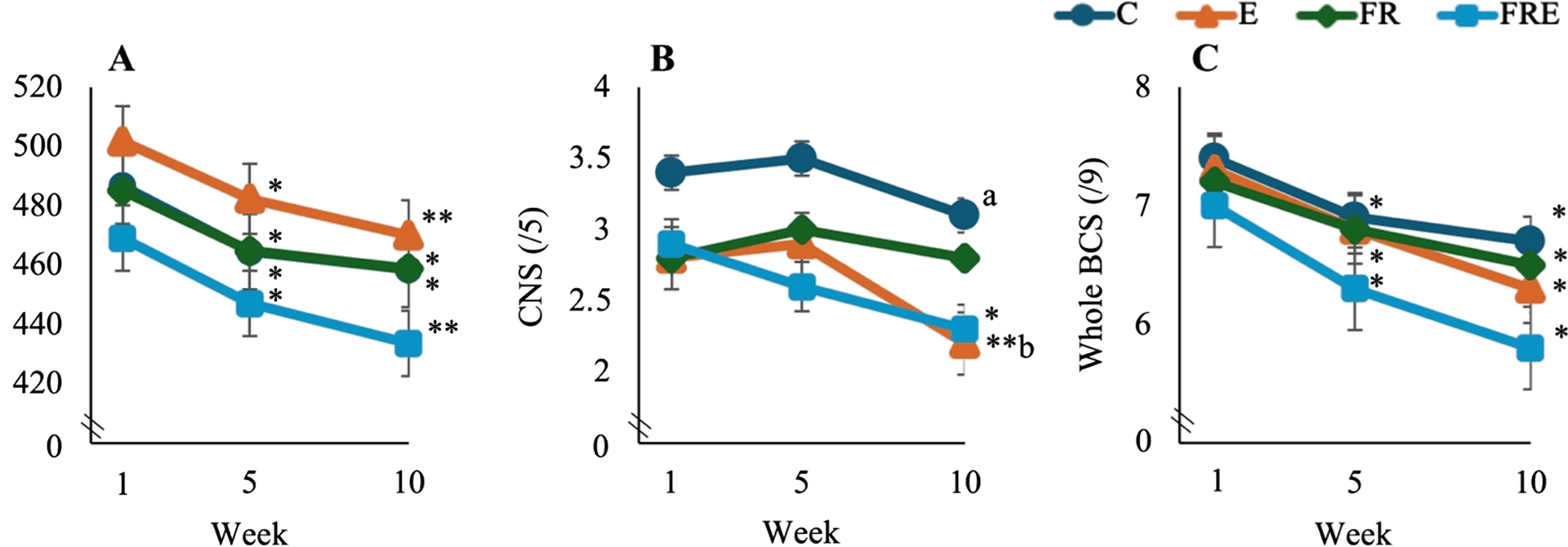Horses & housing
Thirty-two mix breed horses, including 4 geldings and 28 mares, aged 7 to 21 years from the Arkell Equine Research Station (University of Guelph, Guelph, ON, Canada) were enrolled in the 10-week study [Table 1]. Horses were conditioned to become overweight (determined as a BCS of ≥ 7/9, on a 9-point scale) during a 16-week weight-gain program immediately prior to enrollment as outlined in a thesis by Garland [19]. During the weight gain period, horses were fed a nutritionally balanced diet, as determined by a commercial online feed evaluation program (FeedXL; FeedXL; Tamworth New South Wales, Australia) consisting of ad libitum hay, Trimax, Horse Plus (both from Purina, Strathroy, Ontario, Canada), trace mineral salt (Canadian Stockman, Mississauga, ON, Canada), and Canola Oil (No Name, Loblaws, ON, Canada) such that horses were provided with 120% of their DE for maintenance. The first cohort (n = 15 horses) was studied from May to July 2022 and the second cohort (n = 17 horses) from September to November 2022. During the weight-gain program, horses were categorized into a weight classification (class) by how quickly they reached the desired BCS. Class 1 started the conditioning period at a BCS of at least 7/9, class 2 met the desired BCS of 7/9 during the first 6-weeks, and class 3 met the desired BCS of 7/9 after the first 6-weeks [19].
Table 1 A: description of horses at beginning of weight loss period
Horses were group-housed in a large loafing barn bedded with deep-litter straw. The barn was freely accessed by the horses from an outdoor dry lot of approximately 2,000 m2. All horses had no forced exercise for at least 12 months prior to starting the 10-week weight loss trial. Horses had ad libitum access to water and trace mineral salt blocks, and were individually fed hay three times a day (600 h, 1200 h, 1800 h), with a meal supplement at 1200 h (see Table 2 and Feeding Program below).
Table 2 Nutrient composition of hay, salt, and meal feeds on an as-fed basisTreatment groups
Horses were blocked by cohort, sex and class, then randomly placed into one of four groups (n = 8 horses/group). Treatment groups included: Control (C), Feed Restriction (FR), Exercise (E), and Feed Restriction plus Exercise (FRE) (Table 3). C and E horses were fed 100% of their Digestible Energy (DE) requirements (as estimated by FeedXL) and FR and FRE horses were fed 85% DE. Horses in the E and FRE groups were exercised 5x/week (expending ~15% DE)[20-22], C and FR horses did not undergo forced exercise. To minimize the number of animals required for this study, the four C horses from cohort 1 were re-used in cohort 2, with each being placed into one of the four groups.
Table 3 Approximate digestible energy (DE) fed, utilized through exercise, and total available for the horses in each treatment groupFeeding program
Diets were formulated for each individual horse using FeedXL. First cut grass hay was fed as 75% of dry matter (DM) intake of the balanced diet. Horses were individually fed hay three times a day (at 600 h, 1200 h, and 1800 h), and received a meal at 1200 h, which included Trimax, Equilizer, Horse Plus (all from Purina, Strathroy, Ontario, Canada) and trace mineral salt (Canadian Stockman, Mississauga, Ontario, Canada). Nutrient content of the hay was determined at a commercial laboratory (SGS Agrifood Laboratory, Guelph ON Canada) and nutrient contents of the trace mineral salt, Trimax, Equilizer, and Horse Plus were sourced directly from the manufacturers (Table 2). Horses were offered their hay or hay + meal for a total of 90 min per feeding, after which time any uneaten meal and/or hay were removed and weighed. The weight of Trimax and hay in each horse’s diet was reduced every two weeks, the magnitude of reduction determined by the amount of weight the horse had lost in the previous 2-week period. Actual amounts offered to each horse are included as Supplementary File 1.
Exercise program
Exercising horses (E, FRE) underwent submaximal unridden exercise, with a target working heart rate (HR) of 150 bpm, five days a week. Horses wore Polar Equine FT1 (Polar Electro Oy, Kempele, Finland) heart rate monitors once a week during their daily exercise to match workload with heart rate. Horses were hand-walked for 15 min, followed by trotting on a lunge line for 20 min (10 min in both directions) at the targeted HR of 150 bpm, and then hand-walked for a cool-down of 10 min.
Measurements
At the beginning of each week, horses underwent 11 morphometric measurements. All measurements and scores were performed by a single experienced individual. All measurement data are presented for weeks 1, 5 and 10. Morphometric measurements included body weight (BW; kg) via a weight tape (Easy Measure, Sharpe Farm Supplies, Guelph, ON, Canada), cresty neck score (CNS;/5) [23], an average whole body BCS (/9) [24], and 8 individual anatomical BCS (/9; neck, behind shoulder, inner front legs, withers, ribs, crease down back, crease down haunches and tailhead). Weight tape measurements were obtained in triplicates and averaged for a final weight.
Statistical analysis
Statistical analysis was performed in SAS OnDemand for Academics (SAS Studio, SAS Institution Inc, Cary, NC, USA) using proc glimmix. A 2-Way RM ANOVA was run to determine interactions between and within treatment and week. Student residuals were analyzed to ensure a proper fitting model. A Tukey-Kramer post-hoc test was used for multiple comparisons in the simple effect model, sliced by week and by treatment. Least squares means was run to assess each individual treatment time point mean and standard error. To account for any seasonal effect of when the study was conducted, cohort was included as a statistical block and covariance tests were run for cohort and weight classification. An additional individual random statement was run for weight classification. Significance was accepted at P ≤ 0.05. Data are presented as mean ± SEM.

